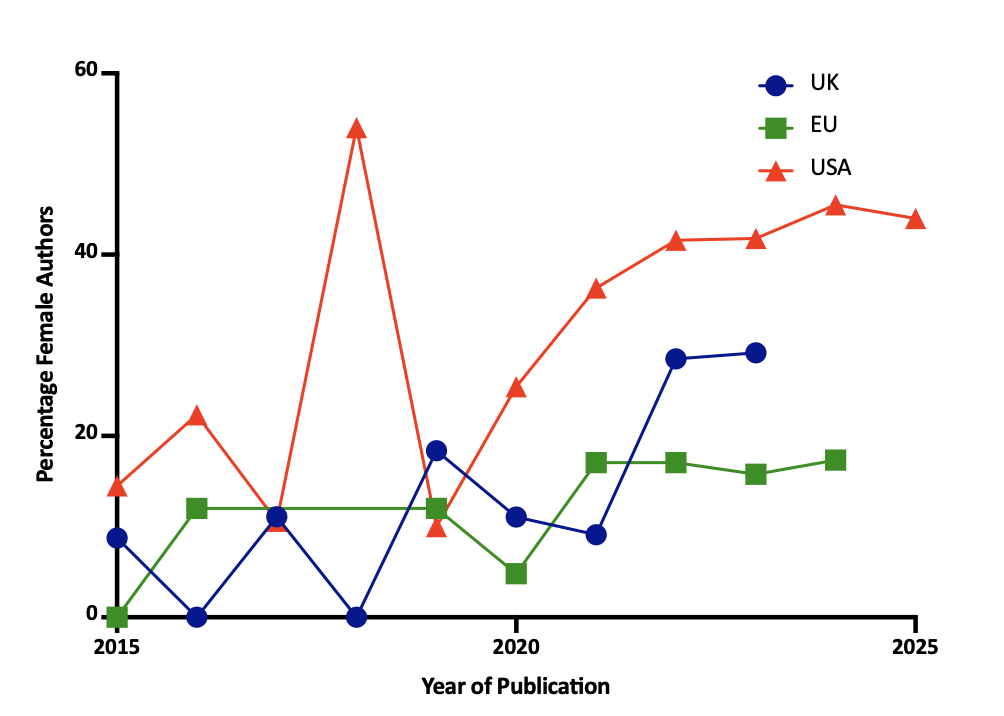Tuesday Poster Session
Category: Practice Management
P6180 - Gender Representation in Gastroenterology Guideline Development: An Analysis of Authorship Trends
Tuesday, October 28, 2025
10:30 AM - 4:00 PM PDT
Location: Exhibit Hall

Erica C. Becker, MD, MPH
SSM Health Saint Louis University Hospital
St. Louis, MO
Presenting Author(s)
Erica C. Becker, MD, MPH1, Adam D. Farmer, MD, PhD2
1SSM Health Saint Louis University Hospital, St. Louis, MO; 2SSM Health Saint Louis University Hospital, Saint Louis, MO
Introduction: Developing guidelines is widely recognized as a marker of professional recognition and influence within a field. Gender plays a significant role in shaping health risks, disease presentations, and treatment outcomes. Equally important, however, is the representation of gender in the creation of the healthcare guidelines to ensure that recommendations reflect the needs of diverse populations.
Methods: We conducted a systematic review of peer-reviewed gastroenterology guidelines published between 2015 and 2025 in Europe, the United Kingdom, and the United States. We extracted author information from guidelines published by the United European Gastroenterology (UEG), The British Society of Gastroenterology (BSG), the American College of Gastroenterology (ACG), and the American Gastroenterological Association (AGA). Authors' gender was classified using an online tool that estimates the likelihood of a name corresponding to a female or male gender, based on a database of over 114 million first names. For names with gender probabilities below 70%, we cross-verified gender using institutional websites and artificial intelligence-based deep search tools (Grok, version 3).
Results: Among 156 guidelines published between 2015 and 2025, the percentage of female authors was 13%, 15.3%, and 29.6% in British, European, and American guidelines, respectively. Female authors were significantly underrepresented in European and British guidelines compared to American guidelines (p< 0.0001). The proportion of female senior authors was 8.5%, 33.3%, and 21.6% in British, European, and American guidelines, respectively. Female senior authors were notably underrepresented in British guidelines compared to European and American guidelines (p=0.049). Over the past decade, there has been a notable increase in the percentage of female authors contributing to guidelines, see Figure 1.
Discussion: The underrepresentation of female authors in guideline development raises concerns about potential gender bias influencing healthcare recommendations. This disparity likely reflects the broader gender imbalance within the field of gastroenterology, which has historically been male-dominated. Currently, in the United States women comprise 18% of practicing gastroenterologists and 33% of gastroenterology fellows. This contrasts with the increasing number of women entering medical school and internal medicine residency at 48% and 40%, respectively.

Figure: Figure 1 – Trends in female guideline authorship from 2015-2025
Disclosures:
Erica Becker indicated no relevant financial relationships.
Adam D. Farmer indicated no relevant financial relationships.
Erica C. Becker, MD, MPH1, Adam D. Farmer, MD, PhD2. P6180 - Gender Representation in Gastroenterology Guideline Development: An Analysis of Authorship Trends, ACG 2025 Annual Scientific Meeting Abstracts. Phoenix, AZ: American College of Gastroenterology.
1SSM Health Saint Louis University Hospital, St. Louis, MO; 2SSM Health Saint Louis University Hospital, Saint Louis, MO
Introduction: Developing guidelines is widely recognized as a marker of professional recognition and influence within a field. Gender plays a significant role in shaping health risks, disease presentations, and treatment outcomes. Equally important, however, is the representation of gender in the creation of the healthcare guidelines to ensure that recommendations reflect the needs of diverse populations.
Methods: We conducted a systematic review of peer-reviewed gastroenterology guidelines published between 2015 and 2025 in Europe, the United Kingdom, and the United States. We extracted author information from guidelines published by the United European Gastroenterology (UEG), The British Society of Gastroenterology (BSG), the American College of Gastroenterology (ACG), and the American Gastroenterological Association (AGA). Authors' gender was classified using an online tool that estimates the likelihood of a name corresponding to a female or male gender, based on a database of over 114 million first names. For names with gender probabilities below 70%, we cross-verified gender using institutional websites and artificial intelligence-based deep search tools (Grok, version 3).
Results: Among 156 guidelines published between 2015 and 2025, the percentage of female authors was 13%, 15.3%, and 29.6% in British, European, and American guidelines, respectively. Female authors were significantly underrepresented in European and British guidelines compared to American guidelines (p< 0.0001). The proportion of female senior authors was 8.5%, 33.3%, and 21.6% in British, European, and American guidelines, respectively. Female senior authors were notably underrepresented in British guidelines compared to European and American guidelines (p=0.049). Over the past decade, there has been a notable increase in the percentage of female authors contributing to guidelines, see Figure 1.
Discussion: The underrepresentation of female authors in guideline development raises concerns about potential gender bias influencing healthcare recommendations. This disparity likely reflects the broader gender imbalance within the field of gastroenterology, which has historically been male-dominated. Currently, in the United States women comprise 18% of practicing gastroenterologists and 33% of gastroenterology fellows. This contrasts with the increasing number of women entering medical school and internal medicine residency at 48% and 40%, respectively.

Figure: Figure 1 – Trends in female guideline authorship from 2015-2025
Disclosures:
Erica Becker indicated no relevant financial relationships.
Adam D. Farmer indicated no relevant financial relationships.
Erica C. Becker, MD, MPH1, Adam D. Farmer, MD, PhD2. P6180 - Gender Representation in Gastroenterology Guideline Development: An Analysis of Authorship Trends, ACG 2025 Annual Scientific Meeting Abstracts. Phoenix, AZ: American College of Gastroenterology.
